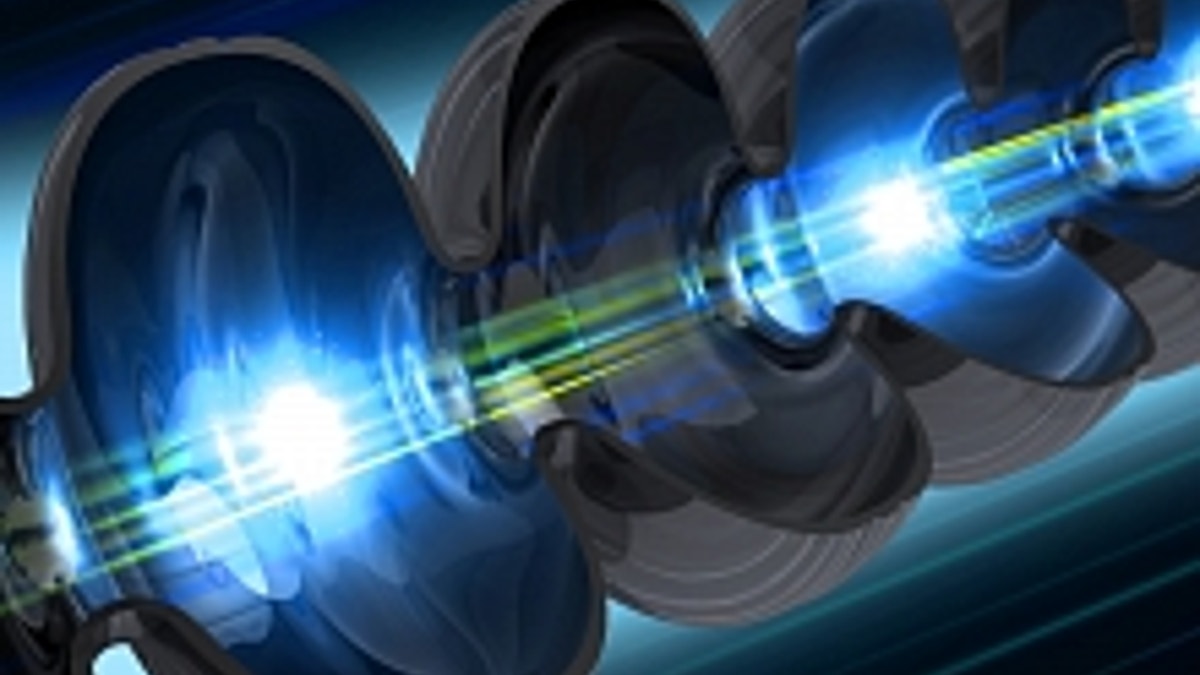
Illustration of an electron beam traveling through a niobium cavity – a key component of SLAC’s future LCLS-II X-ray laser. (SLAC National Accelerator Laboratory)
The fastest and most powerful X-ray laser in the world will soon be an astonishing 8,000 times faster and 10,000 times brighter, enabling scientists to see how nature works on the atomic level and on ultrafast timescales.
Construction began Tuesday on LCLS-II, a “major upgrade” to the Linac Coherent Light Source (LCLS) X-ray laser at the Department of Energy’s SLAC National Accelerator Laboratory in Menlo Park, Calif.
When completed in the early 2020s, LCLS-II will fire up to 1 million X-ray pulses per second, more than 8,000 times faster than LCLS.
Since it became functional six years ago, scientists have used LCLS to view the fundamental processes of nature, including how chemical bonds form and break and how electric charges rearrange in materials and change their properties. The X-ray microscope, operated by Stanford University for the Energy Department’s Office of Science, was the first light source of its kind. It used the brightest and fastest X-ray pulses ever made to provide unprecedented details of the atomic world.
Related: Large Hadron Collider results may hint at a new era of physics
But it’s a Model-T compared to the Ferrari that’s being built.
“LCLS-II will take X-ray science to the next level, opening the door to a whole new range of studies of the ultrafast and ultrasmall,” said LCLS Director Mike Dunne, in a statement. “This will tremendously advance our ability to develop transformative technologies of the future, including novel electronics, life-saving drugs and innovative energy solutions.”
LCLS already enables researchers to view chemical reactions as they happen; to see electrons moving through materials; and to observe the behavior of atoms in stars. It also provides near-atomic-level images of disease-related proteins that could lead to the discovery of potential cures.
Related: Professor solves 300-year-old math mystery, wins $700,000
In LCLS, electrons accelerate down a copper pipe that operates at room temperature and allows the generation of 120 X-ray laser pulses per second.
But LCLS-II will have a superconducting accelerator that conducts electricity at minus 456 degrees Fahrenheit. This will allow it to generate an almost continuous X-ray laser beam with pulses that are 10,000 times brighter than those of LCLS and arrive up to a million times per second.
Like LCLS, it will use electrons moving close to the speed of light to generate beams of extremely bright X-ray laser light. The electrons travel on a zigzag path through a series of magnets, called an undulator, and give off energy in the form of X-rays. It will run parallel to LCLS in SLAC’s 2-mile-long linear accelerator tunnel.
The $1 billion project is being funded by the Energy Department’s Office of Science. Cornell University and four national labs – Argonne, Berkeley Lab, Fermilab and Jefferson Lab – have teamed up with SLAC on LCLS-II’s design and construction.
Related: Scientists solve 350-year-old pendulum clock mystery
“Our lab has a long tradition of building and operating premier X-ray sources that help users from around the world pursue cutting-edge research in chemistry, materials science, biology and energy research,” said SLAC Director Chi-Chang Kao, in the statement. “LCLS-II will keep the U.S. at the forefront of X-ray science.”
“The upgrade will benefit X-ray experiments in many different ways,” said Brown University Professor Peter Weber, “and I’m very excited to use the new capabilities for my own research.
“With LCLS-II, we’ll be able to bring the motions of atoms much more into focus, which will help us better understand the dynamics of crucial chemical reactions.”
